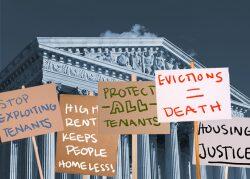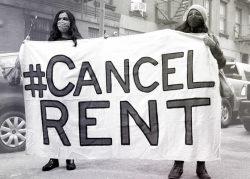 Where the lawsuits challenging NY’s 2019 rent law stand
Where the lawsuits challenging NY’s 2019 rent law stand
Trending
Is NY’s rent law unconstitutional? Second Circuit to rule
Landlords argue 2019 reform amounted to taking of property

Two lawsuits challenging the constitutionality of rent stabilization in New York went to oral arguments in the Second Circuit Wednesday.
The suits — one brought by landlord groups the Community Housing Improvement Program and the Rent Stabilization Association, the other on behalf of mom-and-pop owners Dino, Dimos and Vasiliki Panagoulias — argue that the Housing Stability and Tenant Protection Act of 2019 violates two constitutional amendments.
The parties argue that the law violates the Fifth Amendment’s “takings clause,” which says
the government cannot seize property without compensating owners. The plaintiffs claim that the law eliminated an owner’s ability to use a rental unit for anything but stabilized housing, which amounts to a physical taking.
Another argument is that the law ignores the 14th Amendment’s “due process clause” because it doesn’t fulfill its stated purpose of promoting affordable housing. The 2019 reform ended a rarely used provision that allowed landlords to deregulate units based on their tenants’ income being too high.
The judges spent most of the hearing Wednesday discussing the relevance of the takings clause claims.
Andrew Pincus, a partner at Mayer Brown and the lead attorney for CHIP and RSA, argued that a Supreme Court decision last year established a precedent that the court should consider.
Read more
 Where the lawsuits challenging NY’s 2019 rent law stand
Where the lawsuits challenging NY’s 2019 rent law stand
 Judge says landlords have no constitutional right to “unregulated market”
Judge says landlords have no constitutional right to “unregulated market”
In Cedar Point Nursery v. Hassid, the court ruled 6-3 that a California law requiring employers to allow union organizers to enter their property for up to three hours a day to solicit members was an unconstitutional physical taking.
Pincus said rent stabilization forces owners to renew a lease, which similarly deprives them of the right to exclude someone from their property.
Judge Susan Carney pushed back on the comparison. “Mr. Pincus, Cedar Point was an interesting development, but it occurred in a very different situation,” she said.
The judge said that ruling determined that California could not compel owners to allow labor organizers — third parties with whom they had no relationship — to enter the property for an extended amount of time.
“Here we have a rent control situation. We have owners of property who are in the business of having tenants, third parties on their properties,” Carney said. “That’s how their business model works.”
Pincus countered that the Cedar Point case ruled that owners are entitled to that right to exclude. He said his clients’ claims relate to landlords who want to exit the rental business at the end of a tenant’s lease and are unable to do so, except under “very narrow circumstances.” (The New York law allows deregulation for personal use, for example.)
Kevin King, the attorney arguing the Panagoulias case, piggybacked on that argument, claiming that one of the Panagouliases wanted to move into a rent-regulated building owned by the family but was unable to because of the 2019 law.
Previously, owners could evict a building’s stabilized tenants by claiming they wanted multiple units for personal use. Now, landlords can only claim one unit for themselves or a family member. A tenant who has lived in the building for more than 15 years, however, would be protected from eviction.
King added that before the 2019 law, decontrol provisions — the ability to pull a vacant unit out of regulation if the rent surpassed a certain threshold — allowed owners the “right to exclude.” Since New York did away with vacancy and luxury decontrol, apartments remain regulated regardless of how high the rent or the tenant’s income is or whether a tenant moves out.
“[The argument] is not just about personal use, it’s about the full range of things that owners can do to regain control of their property to exercise the right to exclude,” King said, noting that the majority of those “exit ramps” have been closed.
The city, a defendant in both cases, and the state, the defendant in the Panagoulias suit, both pushed back on the notion that owners do not have escape routes.
“To be a physical taking … it’s not enough to say that there’s one particular use of the property that is limited,” said Claude Platton, an attorney for the city’s Law Department. “They would have to allege that there’s no ability to change the use of that unit.”
Ester Murdukhayeva, an attorney at the state attorney general’s office representing the Division of Homes and Community Renewal, listed the options owners have to alter the use of units.
“A landlord can convert the building to condominiums or co-ops. It can convert it to commercial use for their own business. It can reclaim one unit for personal use,” she said.
“Arguments that those exit ramps are illusory or unavailable, they’re supported by purely speculative allegations. But they’re not sufficient in any event,” Murdukhayeva said.
After more than an hour of arguments, Judge Barrington Parker cut to the chase, asking Pincus: “If you win, what do you want us to say on this physical taking claim?”
Pincus said the court should deem the rent stabilization law, as a whole, unconstitutional, which could move the legislature to enact a new law that passes constitutional muster.
The attorney representing tenants in the CHIP case, Caitlin Halligan, made the novel argument that landlords would hurt themselves by undoing the law because that would exacerbate homelessness, which would drive down property values.
“The record shows that 43 percent of the folks in family shelters are ones who have been displaced from rent-regulated apartments,” Halligan said. “If this court were to enjoin application of rent stabilization laws as my adversaries suggest, that number would clearly go through the ceiling.”
The court will likely produce a decision within the next month or two. A ruling in favor of CHIP and RSA would kick the case back to the trial court. If the landlords lose, which is more likely, they could ask the U.S. Supreme Court to review the case, which was a goal of theirs from the outset.
Nestor Davidson, a professor of real estate, land use and property law at Fordham University, said in a September panel discussion that landlords were unlikely to win in the Second Circuit, but that the Supreme Court’s Cedar Point decision could point to a win for owners if the suit reaches the conservative-leaning high court.
“[Pincus] is going to take one for the team in the Second Circuit, but I think there’s a not-insignificant chance that the Supreme Court takes the case,” Davidson said.
Correction: This article has been updated to reflect that Judge Barrington Parker heard Wednesday’s arguments, not Judge Barrington Carter.




